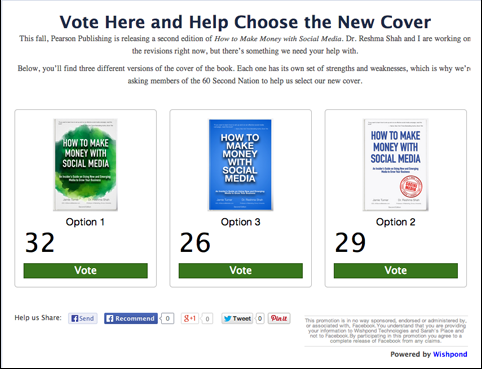Congrats! You’re about to publish your ebook on Kindle Direct Publishing (KDP). Maybe it’s your first, maybe it’s your tenth.
But wait – before you hit that yellow “publish” button – have you thought about how you’re going to market your masterpiece?
Whether your goal is to sell a million copies or just to get your words to connect with the right people who will appreciate your work, you need to plan and act on a great online marketing strategy.
Believe me, just because you’ve put your content into a book doesn’t mean people will be tripping over in crowds to buy it. I know, I’ve done it and I learned the hard way.
Marketing your ebook online can be a tough sell. The reality is that most self-published ebooks are lucky to hit 100 sales (sorry for that splash of cold water). But if you’re willing to do the work, there’s plenty of potential for success. You really do have the world at your fingertips – go ahead and make the most of it.
Here’s 10 steps to marketing your ebook online.
How to Market your Amazon Ebook: Pre-Launch
When you self-publish on Amazon (or any other ebook publishing platform), you’re more than just the author. You’re also the publisher. And that means you get to do the work of any good publishing house team of book editors, graphic designers and marketers. This article is about the marketing side, so I’ll be sticking with methods on how to get your creation viewed, loved and downloaded into the right ereaders.
Aside from the book editing (best to get at least one fresh set of eyes on it), the book title (very important to selling your book as well as SEO) and the book cover (yes, people do judge a book by its cover), there’s a number of pre-marketing steps you need to take.
1. Create a Blog
Hopefully you already have a website and you write blog articles related to your subject matter regularly. If you don’t, start one now.
A website gives you a ‘home’ online. These days, creating your own website is really very easy. There’s lots of places you can get free sites from (just Google it – my personal fave is the free wordpress.com), and most make it very basic to upload design templates and images, so you can create a site that’s reflective of your book and resonates with your audience.
Make sure your site has a blog on it. Why? A blog gives you a chance to showcase your writing, engage with future readers, and (once published) drive traffic to your ebook landing page. And besides, you’re a writer, and a blog gives you a pretty cool outlet to write and write often.
Be sure to enable comments and include social share buttons on all your blog posts to encourage reader engagement.
2. Start to Market with Pre-launch Landing Pages
I know, I know, you’ve read all about the value of building up a great email list – even before you start to publish. Every book I’ve read about ebook publishing told me this too. And it’s true.
Collecting emails is the smartest and most effective way to keep in touch with your future buyers. It’s also a really cool way to start generating interest in your book with pre-launch promotions.
The best ways to do this is through email-gated landing pages (don’t know what a landing page is, but were too shy to ask? Check out my article “ What is a landing page?” – you’re welcome.)
There are tons of pre-launch campaigns you can run on your website landing pages. For example, you can generate leads and excitement about your upcoming ebook by:
- Getting people to choose a book cover (with an email-gated vote contest)

- Hosting an email-gated sweepstakes to give away a free copy of your book
- Engaging your audience by asking for their input about your book characters if it’s fiction (such as a choice your main character must make)
- Engaging your audience by asking for subject matter advice if it’s non-fiction (you can motivate responses by including the best quotes in your book)
Pre-launch promotions can help to start generating that all-important buzz – before you even publish. The more excitement you can generate leading up to your launch, the better chance of success your product will have.
Keep in mind too, that Amazon has lists of top 100 bestselling books. If you can generate a groundswell of interest leading up to publication your book just might make it on to a genre specific list.
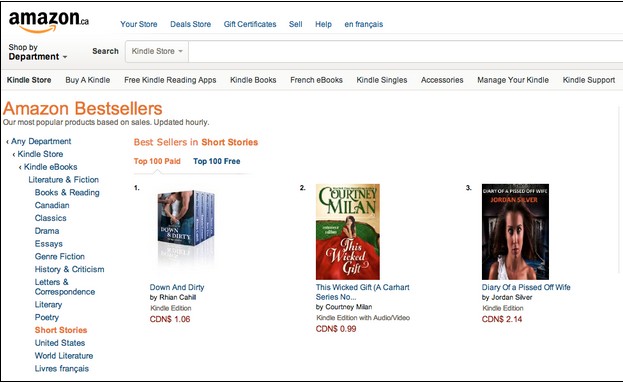
Aside from the dream of being on a bestselling book list, getting into a top 10 spot also helps to sell more of your books. People looking for a new read are more likely to buy a popular choice on a bestseller list.
3. Hyper-target your Reach with Facebook Ads
I hope you’re already marketing your author profile on Facebook and Twitter too (and Good Reads – you definitely need to be networking on the site to connect with your niche readership).
Now, you might be getting lots of engagement on your blog already through your website’s social functions (yes, some websites, like the wordpress.com sites, let you follow fellow bloggers), and you might be getting lots of engagement and click-throughs on your social sites too.
But, you probably want more site visitors, right?
That’s where advertising on Facebook comes in.
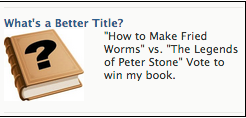
Now, I only recommend that you spend money on Facebook Ads if you’re really serious about selling your ebook. If writing that book was a hobby and you really just enjoyed the process and the people you met along the way, don’t spend lots of money trying to advertise it. The average ad on Facebook costs about $0.50 per click, so do the math for your book (or series of books) to determine if they’re worth it for you.
Having said that, Facebook Ads can be a super effective method of promoting your pre-launch ebook campaigns, get more Likes for your Page and raise awareness about your ebook. The ability to hyper-target your advertising to reach your exact demographic also makes Facebook Ads an incredibly reasonable ad spend.
You can target by:
- All the demographic data Facebook has (such as age, gender, relationship status, location and occupation)
- Pages people Like (such as other books or subjects similar to yours)
- Friends of Fans (to reach Facebook Friends of people who already Like your Page)
- And tons more
Use Facebook Ads to drive Likes on your page and traffic to your email-gated pre-launch website landing pages.
4. Send out Email Marketing Automation Campaigns
When you start to get lead information from people who are genuinely interested in your upcoming book, it’s the perfect opportunity to stay in touch.
Send out regular emails to keep people posted on the progress of your book, more pre-launch campaigns you’re running, new blog posts and to ask people to connect with you on your social sites too.
You can even send out pre-written emails to be triggered and delivered at timed intervals with email marketing automation campaigns. That way you can pre-plan your emails and not have to worry if you got busy with the many other tasks you have going on in your life and happen to, uh, forget to send out your bi-weekly or weekly messages.
The more people get to know you and your work, the more likely they will want to buy your book to support your efforts.
Additionally, from a marketing perspective, email marketing automation campaigns keep building up the buzz about your book launch. If you can do it well, more people will be lining up to buy your book on that all-important first day. And, as mentioned above, the more sales you get in a short time, the better chance you have of getting noticed on a bestselling list.
How to Market your Amazon Ebook: Launch
Okay, so now that you have an excited, intrigued and super-engaged future readership, you’re getting close to having a successful book launch. It does take about 24 hours for your book to go live on Amazon – and other sites like iBookstore, Nook Press and Kobo can take a bit longer. Be prepared with a few more steps to take, just before you press that ‘publish’ button.
5. Make an Ebook Landing Page
Create a landing page (now that you know what a landing page is) on your website where you give your ‘book blurb’ showing the benefits of your book and creating the hook. Include your book cover image and book trailer (if you’ve made one).
If you have ecommerce or payment gateway abilities on your site, link the Call to Action button (your ‘buy now’ button) to it, so people can buy directly from you. Or link it to your Amazon KDP book page once it’s live.
I’d highly recommend you make your landing page in advance to your launch. That way you’re not super stressed and rushed to make a last minute marketing page. Keep it private until the big day.
(Click on the landing page)
[
Once your book has been vetted through KDP and is live, make your ebook landing page public.
By having an ebook landing page on your website (whether you’re selling you book directly or through Amazon), you give yourself more marketing opportunities to promote your book and drive traffic to your site. You can make Google Adwords or Facebook Ads that link directly to your website, for example.
6. Announce your Book Release
Just like a traditional publishing house would, you should promote your ebook with a press release or at least an article on your blog announcing the official launch of your KDP ebook.
Pitch your book to publications that are read by your specific niche readership. This could include:
- Online publications in your niche (if your book is about surfing – pitch to surfing sites, for example)
- Popular (or engaged) blogs related to your book subject matter (get in touch with the main bloggers to pitch)
- Local newspapers and online publications (create a press release with a ‘local author’ spin)
Advanced tip: You could also syndicate your press release through PR sites (there are generally costs associated with these), or sign up for HARO (help a reporter out) to pitch your release when a journalist is looking for a story just like yours.
Be sure to send out your announcement to your email contacts to share your great news and generate a buzz with people who are already interested in your work.
7. Promote your Amazon KDP Ebook to your Email Leads and Social Media!
Once you’ve hit the publish button on Amazon KDP, send out a series of personalized emails to your entire prospect database.
Send out your first email before your book is live. Let your engaged readership know that your book is just hours away from being shipped to the Kindle store. Build anticipation by reminding your readers of the hard work you’ve done and the benefits they’ll get from reading your work.
As soon as your book is live on Amazon, send out a second email, with a link directly to your NEW book! Now’s the time you really want to push the sale. If you can get even 30 books to sell on your launch day, you’re likely going to make it to a best selling list (and you already know the benefits of getting on that list).

Over the next few days, keep sending out emails with your excitement. Tell your readers about any updates you’ve had with your launch. If you received press coverage – brag about it. If a reader reviewed your book, tell people about it (and encourage other customers to do the same).
Promote your launch on all your social media sites too. Include the link directly to your Amazon page to make it easy to immediately buy your book.
How to Market your Amazon Ebook: Post-Launch
Once your book is launched, and you’ve successfully made it on at least one sub-genre bestselling list_ (you can do it!)_, you still have tons of opportunities to keep promoting your masterpiece. In fact, the marketing is just beginning.
There are hundreds of ways to promote your ebook online. I’ll give you my top three best methods of connecting with the right readership and getting more copies of your book sold.
8. Set up a “Review your Kindle eBook” landing page
There’s nothing so rewarding as getting your first book review (and hopefully it’s a good one!). To persuade people to write good things about you, you could send out your ebook to review sites or ask your friends. Both of these are great methods, particularly the former. There are lots of great book review sites (including reviews within the GoodReads site – which show up on certain ebookstores too). Find your review sites within your genre and submit your book.
There is a more advanced way to get reviews too. I’d suggest you do this, as you’ll likely get reviews back. And those reviews will be from genuine fellow authors who already hold you in a good light.
What’s this advanced method?
Offer to review other authors’ ebooks – for free.
Create a landing page on your author blog, where writers in your niche can submit (or link) to their work. Let them know that you will review their book, and post that review on your blog (with a linkback to their site and book page).

When you offer to give reviews, you can also ask fellow self-published authors to reciprocate. They’ll likely be more receptive and willing to give you positive feedback.
The more you can connect with your community and niche of fellow self-published authors, the better marketing potential you have. If they share your ebook with a review on their blog, you’ve just exposed your market reach to their audience too. It’s a very ‘pay it forward’ type way of getting your name out there – and you may just sell more books by doing it.
Example of a few reviews on the GoodReads site:
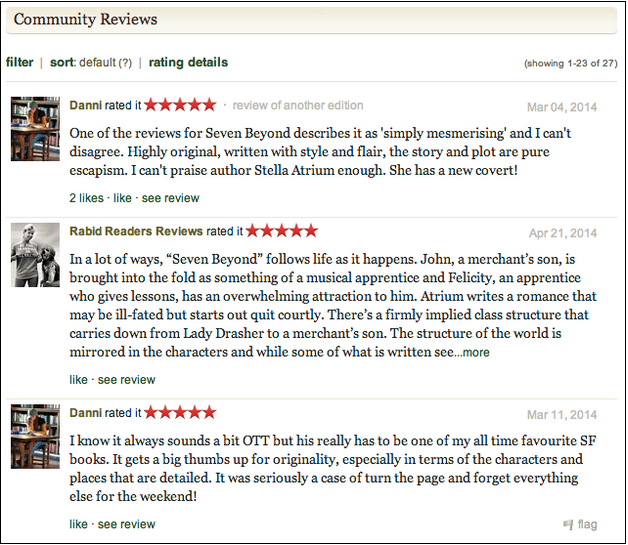
9. Schedule a Virtual Book Tour
You’ve heard about the elusive yet alluring traditional book tour. Maybe you’ve been to a few, to see your favourite authors. Maybe it’s been a dream of yours to actually go on one of your own.
There’s now a modern version, that’s some smart indie authors do. I call it the virtual book tour.
A virtual book tour is a pretty cool method of getting out the word for your ebook. It takes the concept of the old-school in-person book tour, removes the costly travel expenses, and gives you the opportunity to speak to more of your audience in a shorter time.
It’s best to schedule a book tour with back-to-back interviews, podcasts, webinars and Google+ Hangouts (G+ hangouts are particularly great for sci-fi or tech related books).
A short time frame gives you a rapid, condensed hit to your book title (and hopefully book sales). And, as you know, if you can get your book onto the top bestsellers within your particular genre (no matter how small a niche it is), your book appears on Amazon’s top 100 list. This can exponentially increase book sales and awareness.
How to make a book tour:
- Contact influential and highly engaged bloggers within your niche.
- Pitch your book and ask for an interview – offer the interviewer something in exchange such as an interview swap, book review or guest blogging opportunity.
- Try to schedule your ‘tour’ within a one week or day time period.
- Promote your book tour on your social sites and to your email subscribers.
Take your book tour a step further by making recordings of your interviews and sharing them on a “book tour” page you create on your website. Include links back to your influencer’s sites.
10. Promotions and Referral Coupons
Just like in a bricks and mortar bookstore, a great promotion can send your sales through the roof.
Kindle has exclusive book promotion offers for its authors. Take part in these, when you can. A few times a year (or so), KDP authors can give away their books for free – for a limited time.
Now, you may think this goes against your goals of making money from your creative work, but it actually helps to spread the reach to your readership. I’d suggest you take part in these sitewide offers when you can.

Free promotions are particularly effective if you have a series of books. Give away your first book for free and promote your additional books with images of your book covers on the last page of your free book.
Another great promotional method is referral coupons. You may know the concept of referral coupons from large multi-national retailers. Starbucks frequently uses them, for example, as have traditional walk-in bookstores. Why do you think they deploy marketing tactics that get people motivated to spread the reach of their product and bring in new customers? They work, and have been working to increase sales for decades.
What’s new about referral coupons is that they’re now very easy to make yourself, and you can easily make them online.
To make a referral coupon, uh, use a easy software tool (like Wishpond). Then set up your coupon directly on your website or Facebook Page.
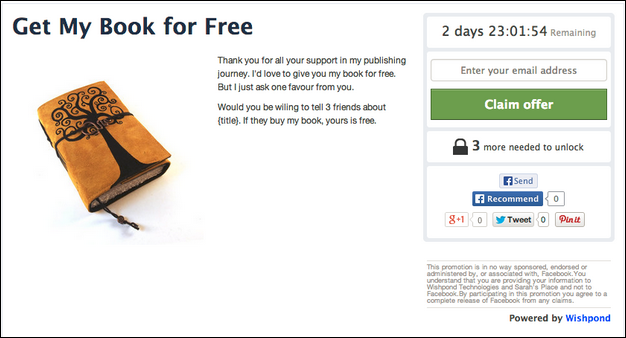
Make an offer to give away your book for free, for example, if a participant refers and gets three people to buy your book.
This is the best kind of word-of-mouth marketing. Your dedicated and loyal audience will tell their friends about you. Friends tend to trust the advice of friends, particularly when they’re recommending something personal, like a book.
Conclusion
Thanks for reading my two part series on how to market your Amazon KDP ebook. I hope you’ve enjoyed it and that you learned something new.
Publishing your own ebook is a great experience. Although you’re not likely to sell a million copies and retire on a yacht somewhere, reaping in the royalties, you never know! Remember, the average self-published author is lucky to sell about 100 books. But if you’re smart and persistent, you could make enough to live off of for a while.
Give these marketing steps a shot. I really do want you to succeed! Let me know how you do and share your ebook marketing tips in the comments below.
Additional online marketing resources:
- The 7 Best Ways to Build your Email List
- What is a Landing Page?
- Landing Pages: The Fundamentals and Conversion Principles
- Landing Pages: Using the Language that Converts
- The Anatomy of a High-Converting Landing Page
- 25 Creative Facebook Contest Ideas You Can Use Today
Wishpond’s Facebook Contest Apps make it easy to create sweepstakes, photo contests, Instagram hashtag contests & more.


